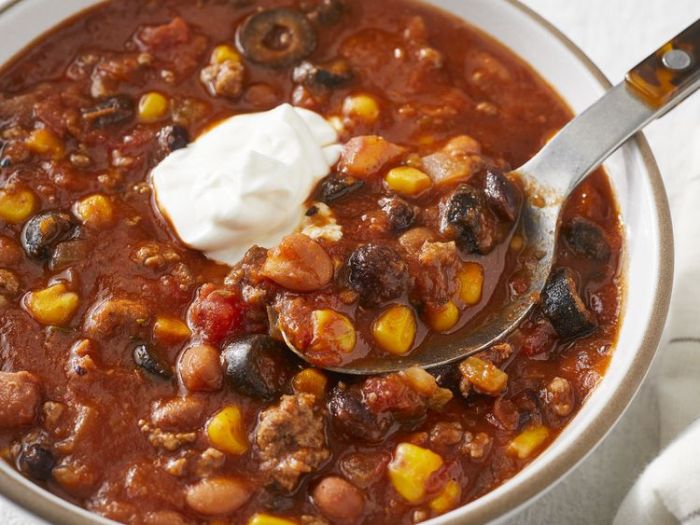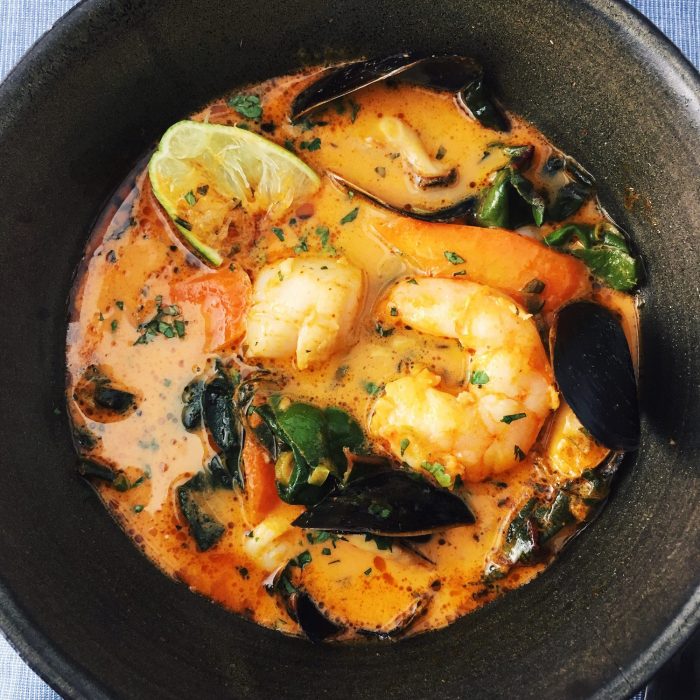Cabbage Roll Recipe Variations with Tomato Soup: Recipe For Cabbage Rolls With Tomato Soup
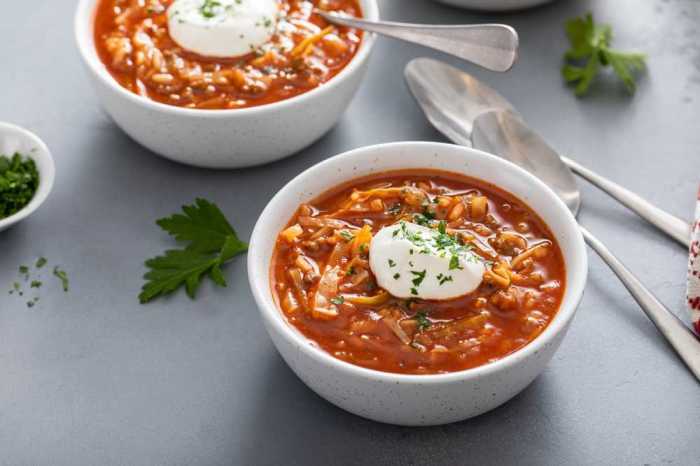
Source: corriecooks.com
Recipe for cabbage rolls with tomato soup – This article explores the versatility of cabbage rolls by showcasing three variations using different meats (beef, pork, and chicken), each simmered in a flavorful tomato soup base. We’ll delve into the nuances of tomato soup selection, filling preparation techniques, cooking methods, serving suggestions, and visual descriptions to help you create a truly memorable dish.
Recipe Variations with Different Meats
The following recipes utilize tomato soup as a unifying element, showcasing how different meats impart unique flavors and textures to the cabbage rolls. Each variation includes detailed instructions for preparing the cabbage leaves.
Beef Cabbage Rolls: Begin by blanching the cabbage leaves in boiling water for about 2 minutes to soften them. This makes them pliable and easier to roll. For the filling, use a combination of ground beef, finely diced onion, rice, and herbs. The beef adds a rich, savory depth to the overall flavor. Season generously with salt, pepper, and paprika.
Pork Cabbage Rolls: Similar to the beef variation, blanch the cabbage leaves until slightly softened. For the pork filling, use ground pork, finely chopped apples, and a blend of sage and thyme. The apples add a subtle sweetness that balances the richness of the pork. The sage and thyme provide an earthy aroma and flavor.
Chicken Cabbage Rolls: Here, use a slightly different approach to preparing the cabbage leaves. Instead of blanching, carefully remove the core from the cabbage and separate the leaves individually. This method preserves the leaves’ structural integrity. The filling consists of ground chicken, finely diced carrots and celery, and a blend of oregano and parsley. Chicken offers a leaner, lighter flavor profile compared to beef or pork.
| Variation | Meat | Cooking Time (approx.) | Key Ingredients |
|---|---|---|---|
| Beef | Ground Beef | 1.5 – 2 hours (stovetop); 1.75-2.25 hours (oven) | Onion, Rice, Paprika |
| Pork | Ground Pork | 1.5 – 2 hours (stovetop); 1.75-2.25 hours (oven) | Apples, Sage, Thyme |
| Chicken | Ground Chicken | 1 – 1.5 hours (stovetop); 1.25-1.75 hours (oven) | Carrots, Celery, Oregano, Parsley |
Tomato Soup Selection and Qualities
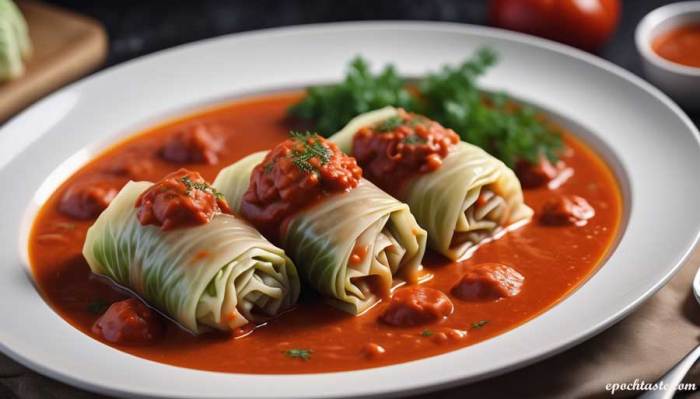
Source: epochtaste.com
The choice of tomato soup significantly impacts the final flavor profile of the cabbage rolls. Using different types, from chunky to smooth or roasted, offers diverse textural and taste experiences. Homemade tomato soup allows for greater control over flavor and ingredients, but store-bought offers convenience.
- Chunky Tomato Soup: Adds texture and visible tomato pieces.
- Smooth Tomato Soup: Creates a smoother, more consistent sauce.
- Roasted Tomato Soup: Imparts a deeper, sweeter, and more complex flavor.
Ideally, the tomato soup should possess a balance of acidity, sweetness, and thickness to complement the richness of the meat filling and the cabbage leaves. Too much acidity can overpower the other flavors, while a lack of thickness might result in a watery sauce.
- Balanced Acidity
- Subtle Sweetness
- Sufficient Thickness
Filling Preparation Techniques, Recipe for cabbage rolls with tomato soup
Three distinct methods can be used to prepare the meat filling, each offering a unique textural and flavor experience. Ground meat provides a more uniform texture, while finely chopped meat offers a slightly coarser, more rustic feel. The choice depends on personal preference.
Method 1: Sautéed Ground Meat: Brown the ground meat thoroughly before mixing in other ingredients. This enhances flavor development.
Method 2: Slow-Cooked Ground Meat: Simmer the ground meat with aromatics for a longer period. This creates a more tender and flavorful filling.
Method 3: Finely Chopped Meat: Finely chop the meat, then combine it with other ingredients. This method creates a more rustic texture.
Rice and Herb Mixture: Rinse the rice thoroughly. Sauté finely chopped onions and garlic until softened. Add the rice and cook for a few minutes. Stir in your choice of herbs (parsley, dill, thyme) and season with salt and pepper.
Cooking Methods and Timing
Cabbage rolls can be cooked using two primary methods: stovetop and oven. Each method offers unique advantages and disadvantages in terms of time, convenience, and texture.
Stovetop Method: Gently simmer the cabbage rolls in tomato soup until tender. This method is faster and allows for more control over the cooking process.
Oven Method: Bake the cabbage rolls in a covered baking dish until tender. This method is more hands-off and allows for even cooking.
| Method | Cooking Time (approx.) | Advantages | Disadvantages |
|---|---|---|---|
| Stovetop | 1.5 – 2 hours | Faster, more control | Requires more attention |
| Oven | 1.75 – 2.25 hours | Hands-off, even cooking | Longer cooking time |
Serving Suggestions and Variations
To enhance the dining experience, consider serving the cabbage rolls with complementary side dishes and garnishes. Dietary adaptations are also possible to accommodate various preferences.
- Side Dishes: Mashed potatoes, crusty bread, steamed green beans, simple salad, and roasted vegetables.
- Garnishes: Fresh parsley, a dollop of sour cream, and grated cheese.
- Dietary Adaptations: Vegetarian versions can substitute lentils or mushrooms for the meat. Low-carb versions can reduce or eliminate the rice in the filling.
Visual Descriptions of the Dish
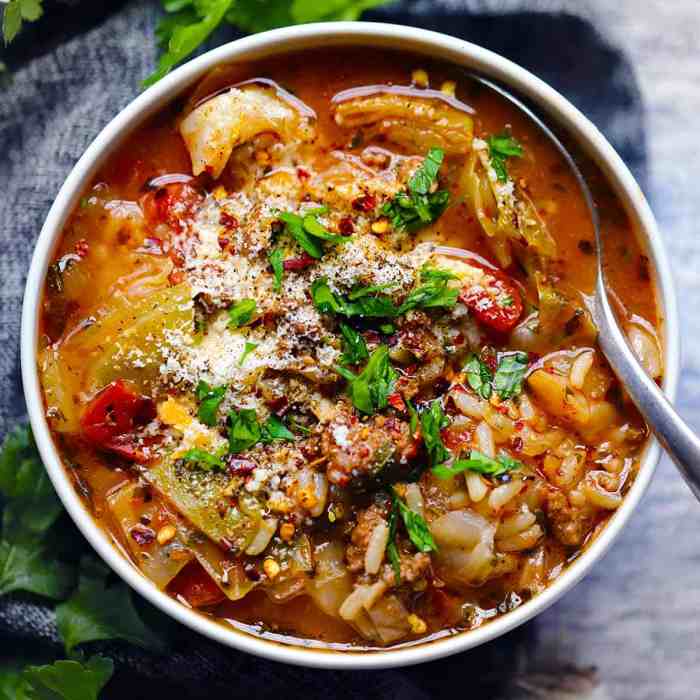
Source: bowlofdelicious.com
Perfectly cooked cabbage rolls should have a tender, slightly softened cabbage leaf exterior, enveloping a flavorful, moist filling. The color should be a rich blend of the cabbage’s green and the filling’s browns and tans. The aroma should be a comforting mix of herbs, spices, and simmered tomato. When served, the dish should be visually appealing, with the cabbage rolls nestled in a vibrant tomato soup, possibly garnished with fresh herbs for a pop of color and visual texture.
A comforting recipe for cabbage rolls with tomato soup often brings back nostalgic feelings. For a different kind of comfort food, you might enjoy a hearty old fashioned salisbury steak recipe with onion soup mix , which offers a savory alternative. However, for a lighter, yet equally satisfying meal, the cabbage rolls with their rich tomato broth remain a classic choice.
FAQs
Can I use leftover cooked meat for the filling?
Yes, leftover cooked meat works well, just be sure to shred or chop it finely before mixing with the rice and herbs.
How can I prevent the cabbage leaves from tearing?
Blanch the cabbage leaves briefly in boiling water to soften them and make them more pliable before stuffing.
What if I don’t have all the herbs listed in the recipe?
Feel free to substitute with similar herbs you have on hand. Experiment to find your favorite flavor combination.
Can I freeze leftover cabbage rolls?
Yes, cooled cabbage rolls can be frozen for later use. Reheat gently in the tomato soup or in a covered dish in the oven.

